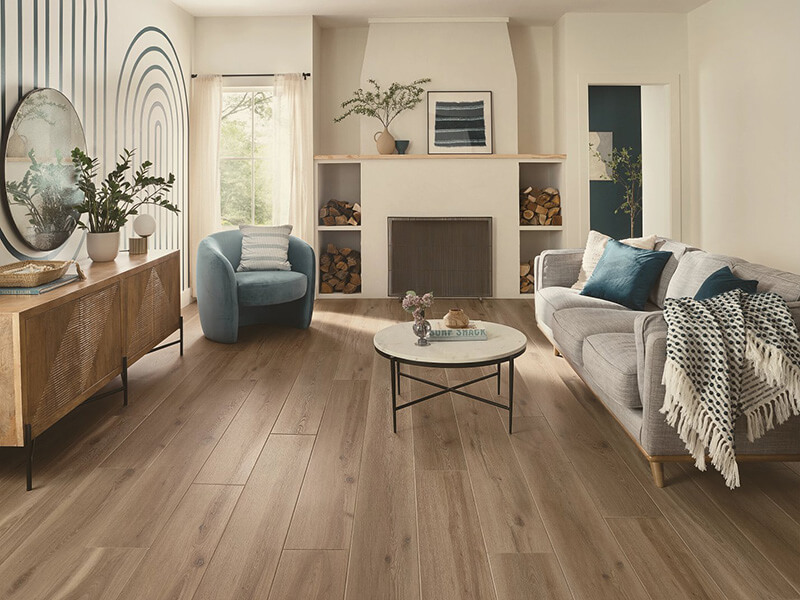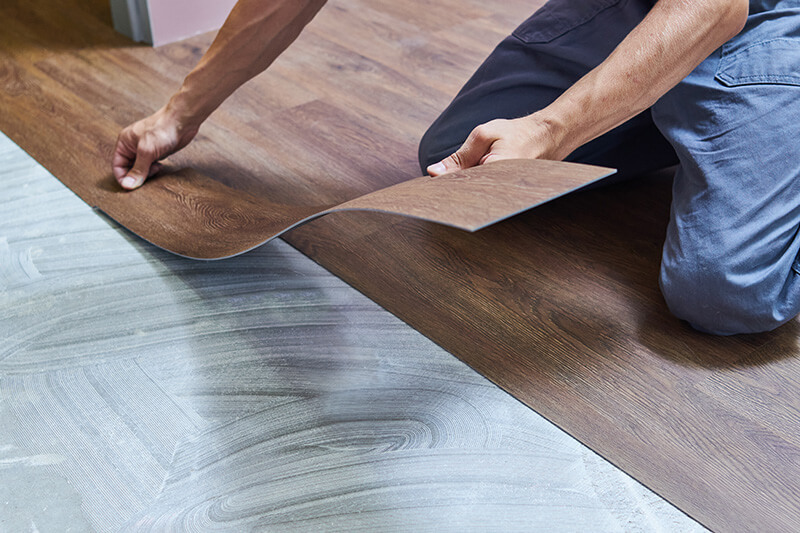How to Choose the Right Installation Method for Luxury Vinyl Flooring
Luxury vinyl flooring has become a top choice for homeowners who want style, durability, and low maintenance in one.
But once you’ve found the perfect product, there’s an equally important decision to make: how should it be installed?

There are two primary installation methods for luxury vinyl: click-lock and glue-down. While both offer waterproof and long-term performance, they’re very different in how they function and what they require. Knowing the difference can help you avoid costly mistakes and choose the best option for your space, budget, and long-term needs.
What Is Click-Lock Luxury Vinyl Flooring?
Also known as floating or interlocking vinyl, click-lock flooring features planks or tiles that snap together using a tongue-and-groove system. These floors are installed over the subfloor without adhesive, so they’re not permanently attached. This “floating” method has become especially popular in residential settings.
Benefits of Click-Lock Installation
One of the biggest benefits of click-lock vinyl is ease of installation. With no glue, nails, or staples required, installation is often faster and more affordable when handled by a professional.
Other benefits include:
- Forgiving on Minor Subfloor Imperfections: While the subfloor still needs to be clean and level, click-lock flooring can handle small irregularities better than glue-down options.
- Removable and Reusable: These floors can typically be disassembled and reinstalled elsewhere, making them a flexible choice if you’re planning future renovations or may move.
- Comfort Underfoot: Often installed with an underlayment, floating floors can feel slightly softer and warmer compared to glue-down options.

Important Considerations for Click-Lock
While click-lock vinyl is convenient, it does come with a few trade-offs.
- Subfloor Still Matters: Though it’s more forgiving, click-lock flooring still requires a clean, dry, and reasonably level subfloor to perform well.
- Expansion Gaps Are Required: Floating floors expand and contract with changes in humidity, so perimeter gaps must be left to allow for this movement.
- Can Be Noisy Without Proper Underlayment: Poor installation or lack of sound-dampening underlayment can lead to a hollow or “clicky” sound when walked on.
- Heavy Furniture Can Restrict Movement: Large appliances or furniture may prevent the floor from moving as it should, potentially causing buckling or separation.
- Seam Vulnerability: While the product itself is waterproof, standing water can still penetrate seams if not cleaned up promptly.
What Is Glue-Down Luxury Vinyl Flooring?
Glue-down vinyl is installed by adhering each plank or tile directly to the subfloor with a specialized adhesive. This creates a more permanent bond, often preferred in high-traffic areas or commercial spaces.
Key Benefits of Glue-Down Vinyl
When properly installed, glue-down vinyl delivers exceptional stability and durability. It resists shifting, won’t lift under pressure from heavy furniture or appliances.
Other benefits include:
- Ideal for High-Traffic Areas: Whether it’s a busy hallway or a commercial entryway, glue-down flooring holds up exceptionally well over time.
- Better Moisture Protection from Above: A properly installed glue-down floor creates a tight seal that helps prevent water from seeping between planks.
- Quieter Performance: Because the flooring is bonded directly to the subfloor, it typically absorbs sound better and feels more solid underfoot.
- Easier to Repair Individual Sections: Damaged planks or tiles can often be replaced individually without disturbing the rest of the floor.
- No Expansion Gaps Needed: Unlike floating floors, glue-down installations generally do not require perimeter expansion gaps.

Important Considerations for Glue-Down
Glue-down luxury vinyl flooring is a durable, long-term solution, but it requires the right preparation and expertise to perform its best. Here’s what to keep in mind when planning for a professional glue-down installation:
- Subfloor Must Be Flawless: Any imperfections in the subfloor—such as debris, uneven areas, or moisture—can show through the finished floor and compromise its performance.
- Installation Costs Are Higher: Because of the detailed subfloor prep and labor-intensive process, glue-down flooring tends to have a higher upfront installation cost.
- Removal Can Be Labor-Intensive: While individual pieces can be repaired easily, removing the entire floor in the future requires significant time and effort due to the permanent adhesive bond.
Click-Lock vs. Glue-Down – Which is Right for You?
Choosing between click-lock and glue-down luxury vinyl flooring depends on your specific needs and priorities.
Which installation method is more complex?
Glue-down is more complex and should always be installed by a professional. Click-lock flooring involves a faster installation process with less downtime, while glue-down requires expert-level adhesive application, layout precision, and curing time.
What kind of subfloor conditions does each method require?
Click-lock flooring is more forgiving of minor subfloor imperfections. Glue-down requires a perfectly clean, dry, smooth, and level surface—any flaws can affect the final result.
How do both methods perform in areas with moisture?
Both are waterproof, but glue-down provides added protection from moisture above the surface. When installed properly, the adhesive creates a tight seal. However, neither method can protect against moisture coming from beneath the subfloor.
Which is better for high-traffic areas?
Glue-down offers superior stability and durability for high-traffic or commercial spaces. Click-lock performs well in typical residential rooms, but glue-down stands up better to heavy foot traffic and frequent use.
How easy is it to repair each flooring type?
Glue-down allows for easier, more targeted repairs. With click-lock, replacing a damaged plank often requires taking apart part of the floor. Glue-down lets professionals replace single planks or tiles without disturbing the surrounding area.
What if I plan to remodel or move in the future?
Click-lock offers greater flexibility for future changes. It can be removed and reinstalled more easily. Glue-down creates a more permanent finish, ideal for long-term flooring plans.
Essential Considerations for Both Methods
No matter which installation method you choose, certain best practices apply across the board. These factors play a key role in the long-term performance, appearance, and comfort of your luxury vinyl flooring.
- Subfloor Preparation Matters: Subfloor prep is the foundation of a successful installation. Skipping this step can lead to uneven surfaces, water damage, or product failure. A professional installer will evaluate and prepare your subfloor before any flooring goes down.
- Let the Flooring Acclimate: Luxury vinyl needs to adjust to your home’s temperature and humidity before installation. Always allow the material to sit in the room for 48 hours to prevent shifting, gaps, or warping later.
- Hire a Professional: Even with a seemingly straightforward product like click-lock vinyl, professional installation can make a significant difference in performance and lifespan. Glue-down installations, in particular, should never be attempted without experience.
Find the Right Fit at Flooring and More in Greater Kansas City
Both click-lock and glue-down luxury vinyl flooring can deliver beautiful, lasting results, but the best choice depends on your space, your goals, and the condition of your subfloor.
For expert advice, professional installation, and a wide selection of high-quality vinyl flooring, visit Flooring and More in , . We will help you make an informed decision and ensure your new floor is installed the right way, the first time.
